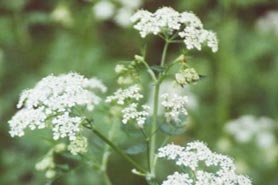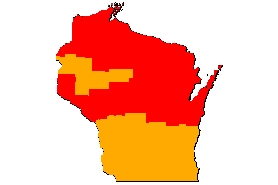Wild Chervil
(Anthriscus sylvestris)
An herbaceous, monocarpic perennial that has hollow stems covered in soft hairs.
Other names for this plant include:
- Common names: bur chervil, cow parsley, keck
- Scientific names: Chaerophyllum sylvestre
Classification in Wisconsin: Prohibited/Restricted (Restricted in Adams, Barron, Chippewa, Crawford, Columbia, Dane, Dodge, Dunn, Fond du Lac, Grant, Green, Green Lake, Iowa, Jefferson, Juneau, Kenosha, La Crosse, Lafayette, Marquette, Milwaukee, Monroe, Ozaukee, Polk, Racine, Richland, Rock, Sauk, Sheboygan, Taylor, Vernon, Walworth, Waukesha and Washington counties; Prohibited elsewhere)
- Ecological Threat
-
- Invades roadsides, open woods, fields and pastures.
- It is a host to the parsnip yellow fleck virus which infects carrots, celery and parsnips.
- It has been planted as an ornamental in some European wildflower seed mixes.
- Identification
-
Leaves: Alternate, fern-like leaflets are nearly hairless with the leaf base clasping the stem.
Flowers: Umbels of tiny, 5-petaled, white flowers blooms late May through early July.
Fruits and seeds: Each flower produces two shiny, long brown joined seeds.
Roots: Thick taproot with lateral buds can be up to 6’ deep.
Similar species: Wild Carrot (Daucus carota; non-native) has bracts at the base of each umbel and often has a purple flower in the center of the umbel. Japanese and spreading hedge parsley (Torilis japonica and T. arvensis; both invasive) leaves are sparse and more freely branching. Poison hemlock (Conium maculatum; invasive) is taller, up to 9.5’, and has ridged stems and purple mottling.
- Control
-
Mechanical: Hand-pull or dig up rosettes or small plants to remove the entire root. Repeated mowing throughout the growing season will deplete root reserves and prevent seed set.
Chemical: Foliar spray with either clopyralid or dicamba before blooming and one month after a pre-bloom cut.
For more information on control techniques, visit the Wild chervil factsheet [exit DNR] by the University of Wisconsin-Extension.
- Resources
- Sources for content:
- Czarapata, Elizabeth; Invasive Plants of the Upper Midwest: an illustrated guide to their identification and control. The University of Wisconsin Press. 2005. Pg. 70-72



